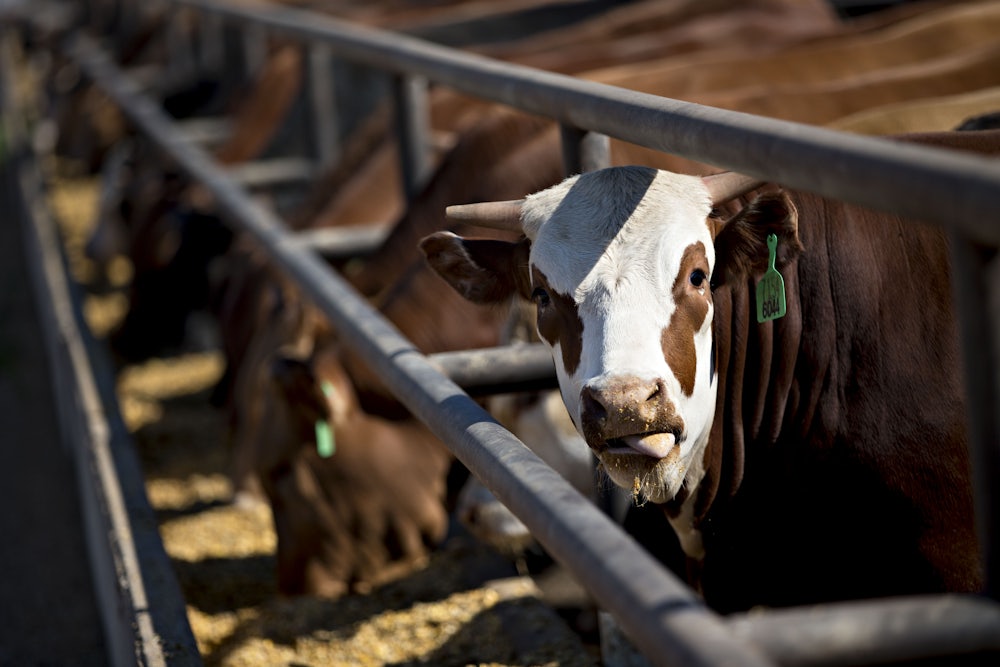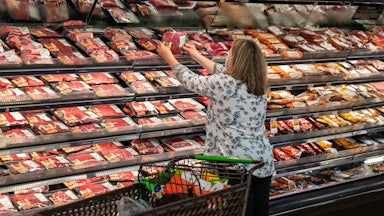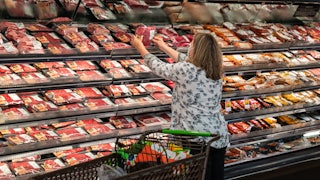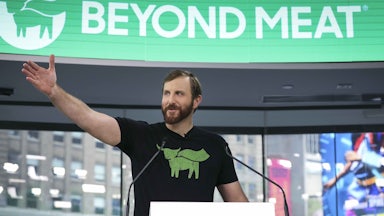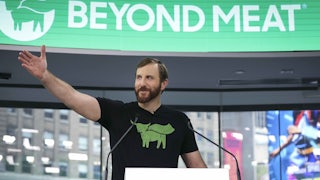Amid ever more frequent climate-related disasters, Americans are becoming increasingly conscious of climate change—and are slowly making the connection between the food they eat and greenhouse gas emissions. The food system’s biggest contributor of greenhouse gases is cows, which create methane through their belches and manure. Most proposals for reducing the climate impact of our diets call for a drastic reduction in beef consumption in high-consuming countries like the United States.
The beef industry has recognized this threat—but also sees a marketing opportunity for greenwashing its products, funding research and public messaging designed to assuage shoppers’ climate concerns. Over the past few years, the industry has helped spread claims that cows can be made low-carbon, with suggestions ranging from cutting emissions by converting manure into biogas to adding methane-inhibiting seaweed additives to cows’ feed, to simply raising and killing them faster.
Now burgers branded with potentially false climate claims are coming to a supermarket near you. Earlier this year, beef giant Tyson launched its Brazen Beef brand, which claims to have a 10 percent reduction in its climate hoofprint. The company has made sure to mention its impressive environmental consulting partners in this effort, like the Nature Conservancy and the Environmental Defense Fund, as a way of juicing up its climate bona fides. Now it has the official blessing of the U.S. Department of Agriculture, which is funding Tyson’s efforts to expand the market for its ostensibly lower-emissions products and, last March, approved a “climate-friendly” label for Brazen Beef. The first products marked with this label launched in supermarkets late last month.
To say there are problems here would be an understatement. The government is not only working with major carbon emitters to promote their products, but it’s providing them a virtual blank check of taxpayer money to do so. It’s the latest instance of a too-close-for-comfort relationship between agri-food corporations and the agency that’s supposed to oversee and regulate them. Beyond the politics, the math behind “climate-friendly beef” just doesn’t add up.
For one, no one can seem to find any evidence behind Tyson’s government-endorsed claim of 10 percent emissions reductions. In January, Matt Reynolds of WIRED looked into the USDA’s plans to support a “Low Carbon Beef” program and found scant information other than that the program might rely on a third-party certification scheme. In May, Emily Atkin and Arielle Samuelson of the popular climate blog Heated attempted a deeper dive but couldn’t get any information on who is collecting the data, where it’s coming from, what methods and models are being used, and whether or how any of the results are being verified. No additional information has come to light since then.
In an email sent after this article was published, a representative from Tyson said that the USDA grant “will not be used to market or commercialize Tyson Foods’ Brazen Beef product,” and that the company had not yet received those funds. “Our application for the USDA Climate-Smart Commodities grant was developed with diverse project partners and is intended to help scale sustainable agriculture that reduce emissions in the production of beef and row crops for livestock feed,” the representative wrote.
Even if all of these protocols do in fact exist somewhere, it’s nearly impossible to confirm such a marginally small reduction in emissions in one specific product. Tyson sources its beef from across a wide range of farms; production methods among farms vary widely, with one study showing a 30 percent variation in carbon emissions between three commonly used beef-rearing methods in the Midwest. Even estimating emissions from a single rancher’s operations can be extremely tricky. What’s more, studies have shown that the methods for estimating emissions employed by the USDA and the Environmental Protection Agency might drastically undercount livestock methane emissions. There’s simply no reliable way to estimate a change in greenhouse gas emissions as small as 10 percent on any one farm—let alone a complex network of them.
If that wasn’t confounding enough, understanding the carbon savings of “climate-friendly beef” depends on what you’re counting down from. One of the trickiest parts about businesses making claims about “low-emissions” products is that much of the time, consumers don’t have sufficient information about what the product in question is being contrasted with. The choice of a baseline matters here—a lot.
There’s a little math involved in understanding the P.R. tricks at play here, so stay with us. One study conducted last year found that the average amount of carbon dioxide needed to produce one kilogram of beef across the U.S. was 21.3 kg of CO2 equivalent (CO2eq). It would be normal to assume that, per its marketing, Tyson’s Brazen products would use around 10 percent less than a similar number—or, at least, use a peer-reviewed baseline average. But the USDA actually allows companies to choose their own baseline from which to market products—and allowed another beef product to advertise itself as “low emissions” using a baseline of 26.3 kg of CO2eq per kilogram of beef. That’s around 11 percent more emissions than the number the other study found was the U.S. average. None of Tyson’s public Brazen materials state what baseline the company will be using to calculate its 10 percent emissions-reduction claim—and the USDA has already proven it’s willing to let companies use baselines that make their products look much better than they are.
The sketchy choice of baseline combined with all the uncertainties involved in quantifying emissions means that any consumer picking Tyson’s “climate-friendly beef” off the shelf hoping to reduce their carbon footprint could actually end up purchasing a product with more emissions than the burger or steak sitting right next to it. But even if we assume none of the aforementioned problems exist—that methods used to calculate emissions are best practice, that the assumed reductions are actually being achieved, and that the 10 percent reduction is compared to an accurate national average—Brazen beef’s emissions would still be higher than those of almost any other food on supermarket shelves except conventional beef (which, for comparison, has more than five times the emissions of tofu).
In a phone call made after press time, a USDA representative said any details about the Low Carbon Beef program, including what baseline is used, could be obtained through a FOIA request.
There should be little doubt that Tyson’s USDA-sanctioned “climate-friendly beef” label will confuse and mislead consumers. Getting consumers to change their diets is notoriously difficult, especially when it comes to making more climate-friendly choices. Asking people to reduce meat consumption runs headlong into a wall of dietary and cultural habits, concerns around food costs and access, and defense mechanisms, especially those awakened by having the government tell them what to eat or by making perceived sacrifices.
That said, studies have shown that labeling the climate impact of foods can shift consumers toward less greenhouse gas–intensive products. In efforts to align consumers’ climate concerns with their purchasing decisions, labels are a small but potentially useful tool. Consumers tend to trust labels that contain expert or government-derived information. But this usefulness and trust is undermined if labels make unverifiable or deceptive claims like “climate-friendly beef.”
All the recent carte-blanche funding and greenwashing that the USDA has provided to major meat companies betray its public mission of regulating U.S. agriculture. The regulatory capture of the agency is so blatant as to be mundane, and its revolving-door policy with industry as unapologetic as in other federal agencies. The current Agriculture Secretary Tom Vilsack, for instance, who also served for eight years under President Obama, spent most of the Trump administration promoting milk as head of the U.S. Dairy Export Council; he has since returned to his USDA post under President Biden. On most issues, Vilsack’s claims align with those of major commodity producers, and his line on meat is no different. He has said he believes that Americans don’t need to reduce the amount of animal products we consume and produce and that marginal methane reductions will instead be sufficient to right the climate ship.
It’s not just Vilsack. Even climate leaders like John Kerry, the Biden administration’s special envoy on climate, have avoided recommendations or even perceptions of advancing meat or livestock reductions, publicly placing their bets on methane-reducing technologies. This new government orthodoxy, however, flies in the face of the latest science, which is clear that reducing both production and consumption of highly-emitting products like beef is a necessary and unavoidable measure to reduce global warming.
The USDA could readily nudge consumers toward gradual beef reduction. Initiatives like universal carbon labels could better inform shoppers about climate impacts across every product. Denmark, for instance, is currently trialing a government-funded “eco-label” project with the goal of building both consumer trust and climate knowledge. The European Union is also working on its own emissions labeling scheme. By providing trustworthy information and more choices, the USDA could help lower emissions without impinging on anyone’s liberty to sell or consume meat.
But instead, the USDA is doubling down on its incumbent-friendly approach of investing in high-emitting products, promoting marginal technological fixes, and putting massive marketing resources behind them. Tyson gets to bask in the good P.R. and cash in on government contracts. And consumers will end up misled by the very government agency meant to educate and empower them.
This article has been updated to include statements from Tyson and the USDA.
